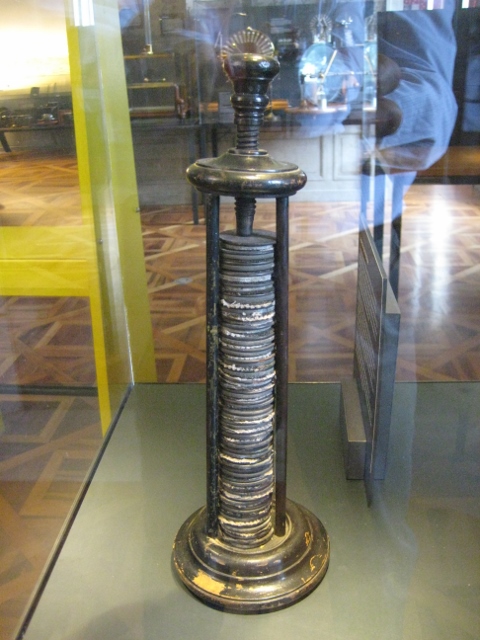The threatened bad weather held off off for another day and it was glorious in the Perle du Lac gardens on the bank of Lake Leman as we arrived at the former mansion that serves as the museum of the History of Science. It had been opened specially for us and there were too many highlights to list, but I found that I was far from the only person on the tour who had never actually seen a George Adams orrery being cranked. It sounds like a coffee grinder.
.jpg) And we had a lovely time discussing its various peculiarities with spurious moons and planets. The hygrometers and other meteorogical instruments that de Sassure took into the mountains were interesting, especially his sky-blueness-scale. On the balcony was a tide gauge used to measure the 73 minute resonant tides of long, thin, Lake Leman. Upstairs was an original Volta pile.
And we had a lovely time discussing its various peculiarities with spurious moons and planets. The hygrometers and other meteorogical instruments that de Sassure took into the mountains were interesting, especially his sky-blueness-scale. On the balcony was a tide gauge used to measure the 73 minute resonant tides of long, thin, Lake Leman. Upstairs was an original Volta pile.
.jpg)
Even the toilet had a display.
.jpg)
After lunch at Le Pied de Cochon in the old city we split into two groups to visit the Patek Philippe Museum and the antique instrument shop of SIS member M. Perret nearby.
I found the conspicuous consumption aspect of the PP products a bit distasteful, and it is strange that the Calvinist burghers of Geneva would never use such things themselves, but as our guide observed, 'Money does not smell'. But there was a whole floor of pre-PP watches, very nicely displayed, and the 'most complicated watches ever made' were amazing. Unfortunately, no photographs allowed, and we did not get any special treatment here.
PP also made the first portable quartz clocks and supplied the readout clocks for the HP cesium atomic time standards in use since the 1970s. There was a wonderful collection of tools of all sorts but our guide was a bit weak on the technical side, and we had to get to the shop. It was quite a candy store and I spent a long time looking for something I could buy with the 50 francs pocket money Kerry had given me. But I found a little 'flea glass', only twentieth century, but with its instruction sheet.
In the evening, we took in the optional concert with the Geneva Chamber Orchestra in the Batiment de Force Motrice, a late nineteenth century hydroelectric power station. All the generators had long gone to the scrap man but some of the iron pipework had survived and was nicely lit to add to the atmosphere. The orchestra was good.
.jpg)